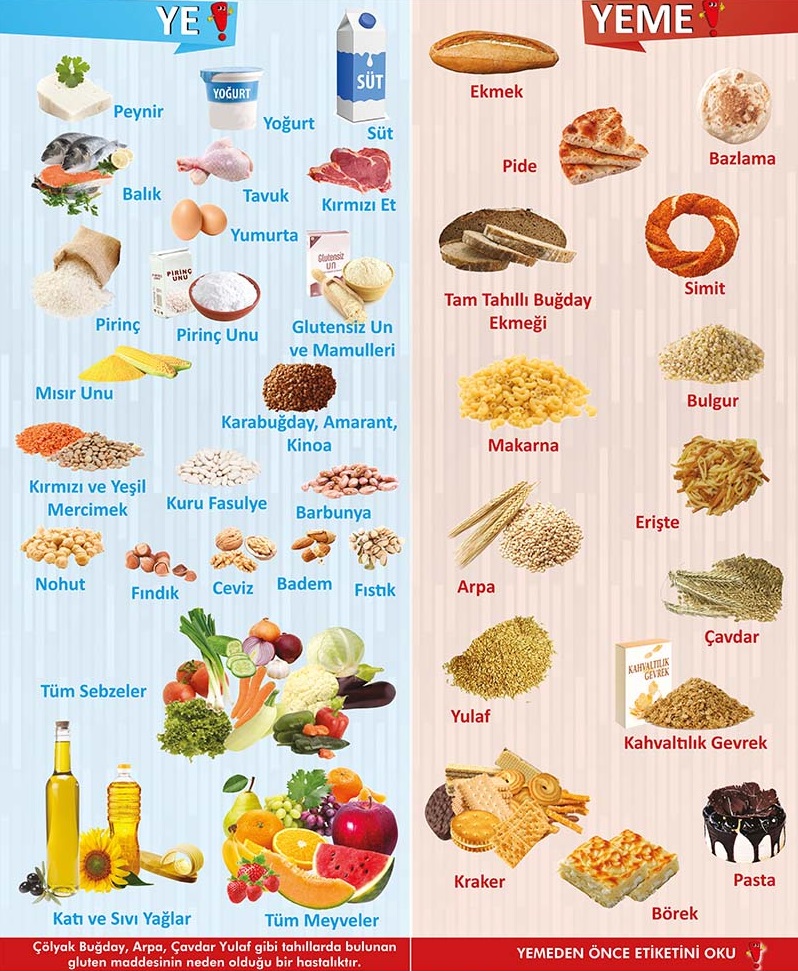Gluten-Free Diet
Gluten Protein
Proteins are found naturally in all living organisms. Gluten proteins make up a large part of the storage proteins in wheat (about 80% of the total protein). Gluten protein is insoluble in water or salt water. The two main proteins in gluten are composed of two fractions, glutenin and gliadin. These two fractions are in almost equal proportions per grain. As a result of the conducted studies, it was determined that the gliadin fraction is toxic to celiacs, and the gluten fraction is less toxic.
What Is Gluten Free Dıet?
Gluten is a type of protein that is easy to digest through the stomach and intestinal tract, but it can cause sensitivity in the intestinal of some individuals and may not be digested.
When applying a gluten-free diet, it is necessary to remove foods such as gluten and gluten-containing flour, bread and pasta from the diet and prevent cross-contamination.
Foods that should be avoided in a gluten-free diet :
• Foods such as bread, biscuits, cakes and cakes prepared from wheat, barley, rye or oat flour
• Attention is paid to the consumption of foods such as sausages, salami, ready-made soups. In such products, gluten acts as a thinner, texturizer, water or fat holder.
Wheat starch and gluten may also be included in the structure of some drugs.
* Pastries sold in bakeries (such as pastries, cakes, pies)
• Whole wheat flour, breadcrumbs, graham flour
* Ready-made bouillons, ready-made soups
* Muesli, spicy rice mixes, crackers and breakfast cereals
* Alcoholic beverages such as malt, beer with malt flavor, vodka
* Semolina, pasta, noodles, bulghur, noodles and couscous
Foods that can be consumed easily in a gluten-free diet :
* Fresh fruits and vegetables
* Types of legumes (such as dried beans, chickpeas, lentils, soybeans, kidney beans)
* Nuts with unprocessed shells (such as hazelnuts, walnuts, almonds)
• Low-fat dairy and dairy products (such as milk, cheese, yogurt, kefir)
* Protein sources such as eggs, chicken, red meat, turkey meat and seafood
• Foods in the cereal group such as corn, quinoa, buckwheat, potatoes, rice and chia seeds
• Gluten-free flours (Flours made from corn, soy, rice, potatoes and beans)
• Gluten-free wheat starch, corn starch and potato starch.
• All fats and oils
• White sugar and brown sugar

Points To Pay Attention in Gluten-Free Diet
1. Transmission can occur frequently on a gluten-free diet, and this leads to health problems. Therefore, more attention should be paid to the materials and tools used. For example, kitchen equipment prepared with wheat flour should be reused after cleaning.
2. Gluten-free and gluten-containing foods should be located in different places and should not be stored side by side.
3. Cooking and storage areas should be well cleaned and ensure that nutrients do not mix with each other.
4. If you are going to eat out, it is important to pay attention to the content of the dishes.
5. It may be difficult for people with gluten intolerance to eat out, especially. For this reason, steamed vegetables, yoghurts and salads can be preferred in addition to the main dishes such as grilled meat, chicken and fish.
Who Should Be Fed Gluten-Free?
The gluten-free diet should be applied for treatment rather than for weight loss purposes. If complaints such as diarrhea, abdominal pain, constipation, bloating, headache are experienced too often, gluten-free diet plans can be tried to eliminate these symptoms.
It should be noted that the majority of gluten-containing foods are rich in vitamins of group B and pulp.
* Celiac patients
• Patients with gluten intolerance
• Individuals with Down syndrome and autism
• Individuals with a doctor's referral